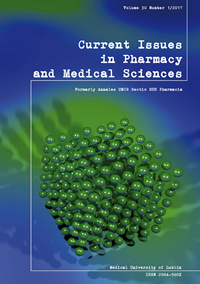Development of herpetic infection associated with stroke and its correction with acyclovir
DOI:
https://doi.org/10.1515/cipms-2017-0004Keywords:
HSV I, Herpes Simplex Virus, stroke, acyclovir, Vero cell cultureAbstract
Background: Herpes simplex virus (HSV) is prevalent in today’s world population, and there is evidence of potential HSV reactivation in patients with immune deficiency induced by acute stroke. However, the data on the use of antivirals in the setting of stroke are scarce. The aim of this study was to evaluate the reactivation of HSV-1 in patients with stroke, using several methods, and to assess the efficacy of acyclovir in the treatment of experimental stroke. In the employed methodology, PCR and dot-ELISA were used to detect the occurrence of HSV-1 in patients with acute stroke. White mice were infected with HSV-1 and experimental stroke was simulated. The infected mice with stroke were subdivided into two groups: one of them received no treatment, while the other one was treated with acyclovir. The level of HSV-1 reactivation was determined by the methods used in human patients. The brain tissue of experimental animals was also subjected to morphological and morphometrical study. The results of such work reveal that, by the applied serological method, HSV-1 was found in all patients with stroke. Herein, the increased level of HSV-1 was seen in the brain tissue and blood in 100% of the experimental infected animals. However, the use of acyclovir suppressed reproduction of HSV-1. Hence, it can be concluded that clinical and laboratory studies have demonstrated the different sensitivity of Dot-Elisa and PCR, with the former being more sensitive. Moreover, the use of acyclovir in the experiment inhibited viral reproduction and further development of viral infection. Still, chemic lesions in the brain persisted.
References
1. Abbott A.L., Nicolaides A. N. Improving outcomes in patients with carotid stenosis. Call for better research opportunities and standards. Stroke, 46, 7, 2015. [Crossref] [Web of Science]
2. Franklin K., Paxinos G. (2001). The mouse brain in stereotaxic coordinates. San Diego: Academic Press.
3. Grose C. Biological plausibility of a link between arterial ischemic stroke and infection with varicella-zoster virus or herpes simplex virus. Circulation, 133, 695, 2016. [Web of Science]
4. Gumenyuk A.V. et al.: Mutual influence of herpes virus infection activate circulation impairment on the state of brain cells. Biopolymers and Cell, 32, 126, 2016. [Crossref]
5. Hara Y. et al.: Herpes simplex encephalitis initially presented with parietal cortex lesions mimicking acute ischemic stroke: A case report. Rinsho Shinkeigaku, 56, 104, 2016.
6. Joshi P.: Multiple strokes associated with herpes simplex virus type-2 infection: case report. J. Neurovirol., 22, 251, 2016. [Web of Science] [Crossref]
7. Kalkonde Y.V., D et al.: Stroke is the leading cause of death in rural Gadchiroli, India. A prospective community-based study. Stroke, 46, 1764, 2015. [Web of Science] [Crossref]
8. Savosko S.I. et al.: Features of Histostructural Changes in Rat Cerebral Cortex in Hemorrhagic Stroke Modeling. International Journal of Physiology and Pathophysiology, 4, 2, 113, 2013. http://www.dl.begellhouse.comru/journals/6ec4ba27650016b1,3301bbf015c9d744,53bfe80d71ecddda.html
9. Snider, S.B. et al.: Hemorrhagic and ischemic stroke secondary to herpes simplex virus type 2 meningitis and vasculopathy. J Neurovirol., 20, 419, 2014. [Crossref] [Web of Science]
10. Terlizzi V., et al.: Primary herpes virus infection and ischemic stroke in childhood: a new association? J. Clin. Neurosci., 21, 1656, 2014. [Crossref] [Web of Science]
11. Zhang H., Li X.: Correlation between inflammatory factors and poststroke pneumonia in diabetic patients. Exp. Ther. Med., 1, 105, 2013.
12. Zis P., et al.: Herpes simplex virus type 2 encephalitis as a cause of ischemic stroke: case report and systematic review of the literature. J. Stroke Cerebrovasc Dis., 25, 335, 2016.
Downloads
Published
Issue
Section
License
Copyright (c) 2017 Authors

This work is licensed under a Creative Commons Attribution-NonCommercial-NoDerivatives 3.0 Unported License.


